Sept. 1 to Sept. 7
In 1899, Kozaburo Hirai became the first documented Japanese to wed a Taiwanese under colonial rule. The soldier was partly motivated by the government’s policy of assimilating the Taiwanese population through intermarriage.
While his friends and family disapproved and even mocked him, the marriage endured. By 1930, when his story appeared in Tales of Virtuous Deeds in Taiwan, Hirai had settled in his wife’s rural Changhua hometown, farming the land and integrating into local society.

Photo courtesy of Wikimedia Commons
Similarly, Aiko Fujii, who married into the prominent Wufeng Lin Family (霧峰林家) in 1927, quickly learned Hoklo (commonly known as Taiwanese) and became an integral part of the household. In fact, she was looked down upon by the local Japanese community due to her marriage and acculturation — much to her distress.
Last week’s feature explored the policy side of Japanese-Taiwanese intermarriage, including how the colonial government saw it as a way to turn Taiwanese into loyal imperial subjects. But such unions were rare, with official figures showing fewer than 500 registered marriages between 1905 and 1942 (not including unofficial cohabitations).
Despite Japanese having the higher status as colonizers, it was often in these spouses’ best interests to integrate into the Taiwanese families and communities as a minority, calling into question the efficacy of assimilation through marriage.
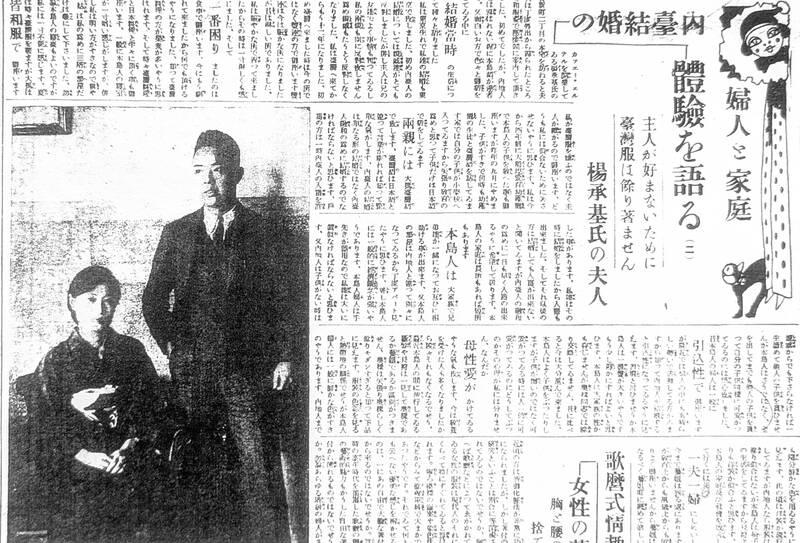
Photo courtesy of National Central Library
ASSIMILATED HUSBANDS
Like many Japanese men who came to Taiwan alone, Hirai was a younger son, ineligible to inherit the family estate — a factor that likely influenced his decision to marry a Taiwanese and settle down, Yukie Tokuda writes in Taiwanese and Japanese interracial marriages: The familial challenges and cultural conflicts during Japanese rule of Taiwan.
Hirai learned Taiwanese and became a translator for the army. His superiors debated his decision to marry Hsieh Shi (謝始), the daughter of a local sugar merchant, but finally approved it, as they thought it would aid assimilation. Two Taiwanese landowners arranged the union, Hirai paid a traditional dowry and more than 1,000 guests reportedly attended the ceremony.
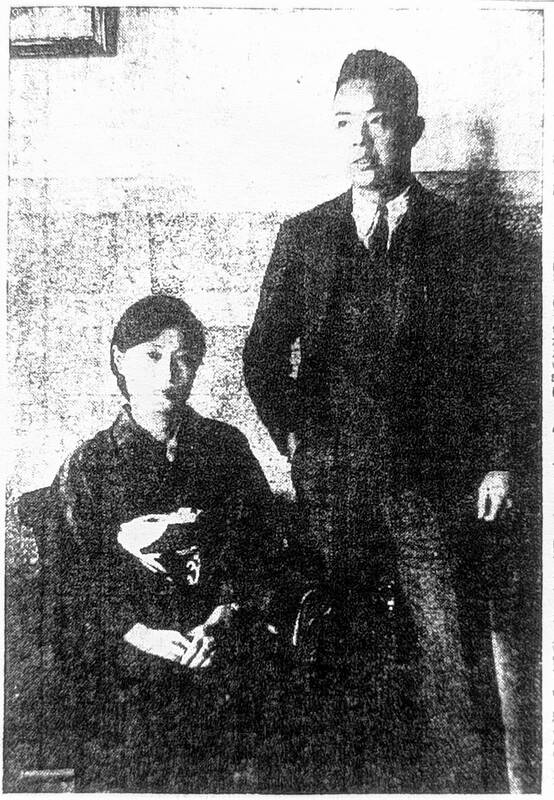
Photo courtesy of National Central Library
Hirai was able to buy land from the government for cheap after he left the army. His eldest son also married a Taiwanese and helped on the farm, while two other sons married Japanese and became schoolteachers. Hirai hoped that his remaining children would choose Taiwanese spouses.
While pairings between Japanese men and Taiwanese women were more common than the reverse during the first two decades of Japanese rule, few made it official as husbands couldn’t afford the hefty dowry. Those with means often chose Japanese wives.
Even so, it was usually the husband who assimilated. A 1919 survey found that among 90 such unions, 35 households adopted a wholly Japanese lifestyle, 33 blended both cultures, and 22 followed Taiwanese customs.
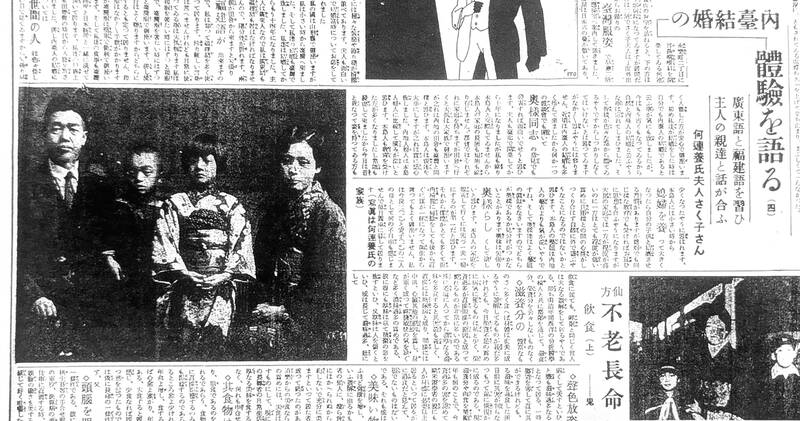
Photo courtesy of National Central Library
TAIWANESE HUSBAND, JAPANESE WIFE
While marriages between a Taiwanese man and a Japanese woman were not legalized until 1920, there were a few notable early unofficial unions.
Rao Yung-chang’s (饒永昌) case fit what the Japanese envisioned. Just 15 when colonial rule began, he mastered Japanese, served as an interpreter, later becoming a local official and earning official gentry status. He was also a successful businessman, donating generously to local infrastructure, education and disaster relief while maintaining close ties to the government.
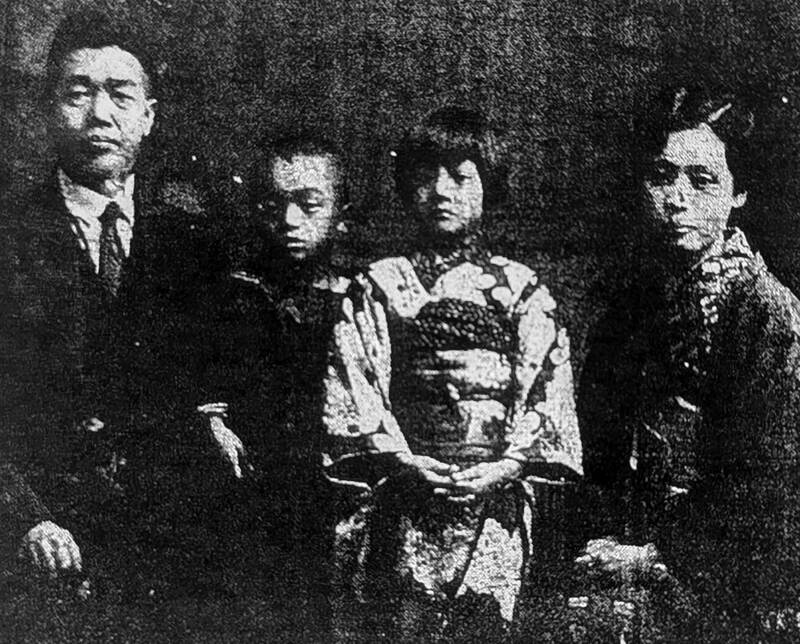
Photo courtesy of National Central Library
Rao married a Japanese woman sometime between 1906 and 1910 and they had four children, all educated in Japan. They lived in a Japanese-style house and adopted Japanese customs in full, serving as a model example of assimilation.
By contrast, Liao Hsi-tung (廖西東), who had a similar life trajectory, was pro-Taiwanese and active in the nonviolent resistance movement during the 1920s. Both he and his son married a Japanese, yet they maintained a mostly Taiwanese lifestyle.
“This shows that if the husband doesn’t want to adopt Japanese culture, there’s little the wife can do to influence him in a patriarchal society,” Tokuda writes. “Marrying a Japanese wife did not mean that they wanted to become Japanese.”
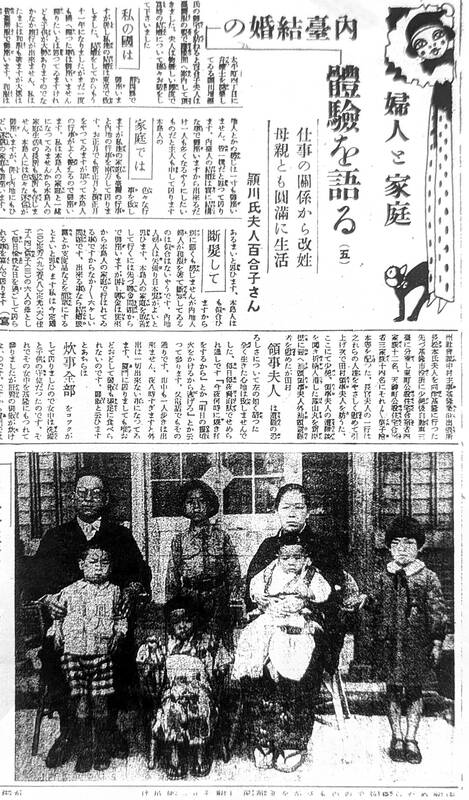
Photo courtesy of National Central Library
There were far fewer marriages between Japanese and those from Taiwan’s indigenous community, at first mostly political alliances that often ended with the Japanese husband abandoning the family.
FEATURED PROFILES
Han Taiwanese men marrying Japanese women became increasingly common in the 1920s, eventually surpassing the opposite. Many of these men came from privileged backgrounds, dating and marrying their wives while studying or working in Japan — often to the dismay of their families.
In 1933, the Taiwan Daily News ran a 11-part series profiling such couples. The women mostly grew up in Japan, only relocating to Taiwan for their husbands.
Hsu Chang’s (許章) wife Ueno spoke decent Taiwanese and preferred wearing Taiwanese clothes, although the family lived in a Japanese-style house. She maintained good relations with Hsu’s relatives and women in the community, telling the newspaper that she felt no difference in sentiment between Taiwanese and Japanese.
By contrast, Tsai Shih-ku’s (蔡氏穀) wife Chiyoko never learned the language. Her husband forbade her from wearing Taiwanese clothing and they lived an entirely Japanese-style life. This made her feel isolated, telling the newspaper that she longed to interact more with local women.
Roughly half of these marriages faced opposition or social disapproval, but instead this strengthened the couples’ resolve to sustain their unions. Due to the superiority complex of Japanese living in Taiwan, these couples often felt more discrimination in Taiwan than when they lived in Japan.
“After returning to Taiwan, we were surprised to find that the Japanese here were narrow-minded, often making sarcastic and hurtful remarks. This made us so weary that we came to dislike Taiwan for a time,” Lin Hsiung-kuang (林熊光) told the newspaper.
Such struggles of identity, belonging and culture in mixed marriages — for both spouses and their children — became the theme of several literary works, most notably in Soichi Shoji’s 1940 novel, Madam Chen (陳夫人).
FAMILY POLITICS
Among the “five major families” of Taiwan, the Wufeng Lin clan recorded the highest number of intermarriages — totalling 10 unions. Despite being known for their pride in Taiwanese culture and role in anti-colonial activities, they also maintained a good relationship with the government.
Political activist Lin Hsien-tang’s (林獻堂) second son Lin Yu-lung (林猶龍) was the first to marry a Japanese, the aforementioned Aiko Fujii. She took care of her in-laws well and often helped Lin Hsien-tang translate when dealing with Japanese, and despite his distaste for colonialism, Lin approved of Fujii as a daughter-in-law.
By contrast, he vehemently objected to elder son Lin Pan-lung (林攀龍) wanting to marry a woman also surnamed Lin — a taboo in Han society — even physically punishing him for his insistence.
The end of colonial rule in 1945 was a turning point, as most Japanese men were forced to leave Taiwan. The Taiwanese wives could follow — but only if their marriages were formally registered, writes Yang Pei-wen (楊裴文) in The study of interracial marriages between Taiwanese and Japanese during the Japanese colonial period (日治時期「內台共婚」研究).
The Japanese wives who chose to stay in Taiwan often concealed their identity due to anti-Japanese sentiment under Chinese Nationalist Party (KMT) rule. Many were unable to return home to see their families until international travel restrictions were relaxed decades later.
Taiwan in Time, a column about Taiwan’s history that is published every Sunday, spotlights important or interesting events around the nation that either have anniversaries this week or are tied to current events.

This is the year that the demographic crisis will begin to impact people’s lives. This will create pressures on treatment and hiring of foreigners. Regardless of whatever technological breakthroughs happen, the real value will come from digesting and productively applying existing technologies in new and creative ways. INTRODUCING BASIC SERVICES BREAKDOWNS At some point soon, we will begin to witness a breakdown in basic services. Initially, it will be limited and sporadic, but the frequency and newsworthiness of the incidents will only continue to accelerate dramatically in the coming years. Here in central Taiwan, many basic services are severely understaffed, and

Jan. 5 to Jan. 11 Of the more than 3,000km of sugar railway that once criss-crossed central and southern Taiwan, just 16.1km remain in operation today. By the time Dafydd Fell began photographing the network in earnest in 1994, it was already well past its heyday. The system had been significantly cut back, leaving behind abandoned stations, rusting rolling stock and crumbling facilities. This reduction continued during the five years of his documentation, adding urgency to his task. As passenger services had already ceased by then, Fell had to wait for the sugarcane harvest season each year, which typically ran from

It is a soulful folk song, filled with feeling and history: A love-stricken young man tells God about his hopes and dreams of happiness. Generations of Uighurs, the Turkic ethnic minority in China’s Xinjiang region, have played it at parties and weddings. But today, if they download it, play it or share it online, they risk ending up in prison. Besh pede, a popular Uighur folk ballad, is among dozens of Uighur-language songs that have been deemed “problematic” by Xinjiang authorities, according to a recording of a meeting held by police and other local officials in the historic city of Kashgar in

The People’s Republic of China (PRC) was out in force in the Taiwan Strait this week, threatening Taiwan with live-fire exercises, aircraft incursions and tedious claims to ownership. The reaction to the PRC’s blockade and decapitation strike exercises offer numerous lessons, if only we are willing to be taught. Reading the commentary on PRC behavior is like reading Bible interpretation across a range of Christian denominations: the text is recast to mean what the interpreter wants it to mean. Many PRC believers contended that the drills, obviously scheduled in advance, were aimed at the recent arms offer to Taiwan by the